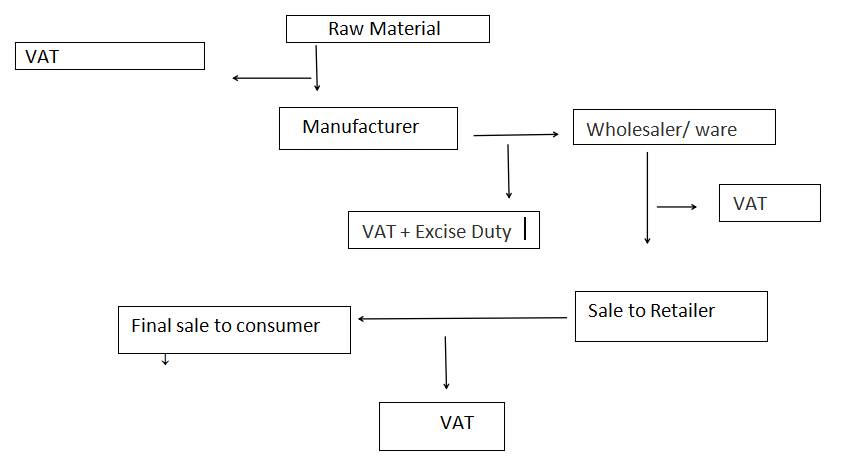Goods and Services Tax – Transforming the Indirect Taxation System!

What is GST (Goods and Service Tax) and how is it beneficial for all?
Table of contents:
Through this article, we will get detailed view of GST-its calculation and how it is befitting manufacturer, Trader (businesses) and consumers:
- What is GST?
- Tax Rates under GST
- GST Returns
- Tax Structure
- Tax Calculation
- Benefits of GST
- Components of GST
- Compliance under GST
What is GST?
GST (Goods & Service Tax) is a single tax applicable to the supply of goods and/or services right from the manufacturer to consumer. Being an indirect tax, it has subsumed (replaced) many indirect taxes such as VAT, Excise duty, Service tax and others. Credits of input taxes are paid at each stage and are available in the subsequent stage of value addition, which makes it essentially a tax applied only on value addition at each stage. The final consumer (consumption-based tax) would have to bear only the GST charged by the last dealer in the supply chain, with set-off benefits at all the previous stages.
In other words, Goods and Services Tax law can be understood as a comprehensive, multi-stage, destination-based tax that is levied on every value addition. It is considered as a single domestic indirect tax law for the entire country.
Tax rates under GST
The GST Council has assigned GST rates to different goods and services. While some products are purchased with none GST, there are others that come at 0% GST, 3% GST, 5% GST, 12% GST, 18% GST, and 28% GST. GST rates for goods and services are changed some time since the new tax regime was implemented from 1st-July-2017.
GST Returns
GST return is kind of a document containing details of income (Sales) which a taxpayer is required to file with the tax administrative authorities. This is often utilized by tax authorities to calculate liabilities.
Under GST, a registered dealer needs to file GST returns that include:
1. Purchases
2. Sales
3. Output GST (On sales)
4. RCM (GST paid on purchases)
GST compliance purchase and sales invoices are required to file GST returns.
Types of GST Returns
| 1 | GSTR-1: This return is for outward supplies (Sales) |
| 2 | GSTR-2A: This is auto-populated return for inward supplies (Purchase) |
| 3 | GSTR-3B: This is summary of inward and outward supplies |
| 4 | GSTR-4/CMP-08: This return is for composition dealers |
| 5 | GSTR-5/5A: This return is for non-resident taxable persons and OIDAR |
| 6 | GSTR-6: This return is for input service distributors (ISD) |
| 7 | GSTR-7: This return is for taxpayers deducting TDS |
| 8 | GSTR-8: This return is for e-commerce operators collecting TCS |
| 9 | GSTR-9: This annual return is for all normal taxpayers |
| 10 | GSTR-9A: This annual return is for composition dealers |
| 11 | GSTR-9B: This annual return is for e-commerce operators collecting TCS |
| 12 | GSTR-9C: This return is for taxpayers whose accounts audited by a CA |
| 13 | GSTR-10: This return is for the taxpayer whose GST registration is canceled |
| 14 | GSTR-11: This return is for Unique Identification Number holders |
Tax Structure
Before the advent of Goods or Services, the structure of indirect tax (old tax regime) levied in India was as follows:
Previous tax structure

As per the GST regime, the tax is levied at every point of sale. In the case of intra-state sales, Central GST and State GST are being charged. All the inter-state sales are being charged to the Integrated GST.
GST structure (GST at 6%)

Tax Calculation (Old tax regime VS GST)
Let’s understand the process of tax calculation of under old tax regime and GST:
| Manufacturer Value | Old tax System | GST (New tax system) |
| Production Cost | Rs. 3,00,000 | Rs.3,00,000 |
| Profit Margin (10%) | Rs.30,000 | Rs.30,000 |
| Excise duty (12%) | Rs.36,000 | – |
| Total production cost | Rs.3,66,000 | Rs.3,30,000 |
| VAT (12.5%) | Rs.45,750 | – |
| SGST of (6%) | – | Rs.19,800 |
| CGST (6%) | – | Rs.19,800 |
| Invoice value for manufacturer | Rs.4,11,750 | Rs.3,69,600 |
| Value to Wholesaler | ||
| Cost of goods | Rs.4,11,750 – 45,750 = 3,66,000 | Rs.3,69,600 – 39600 = 330000 |
| Profit margin (10%) | Rs.36,600 | Rs.33,000 |
| Total Value | Rs.4,02,600 | Rs.3,63,000 |
| VAT (12.5%) | Rs.50,325 | – |
| SGST of 6% | – | Rs.21,780 |
| CGST of 6% | – | Rs.21,780 |
| Invoice value to wholesaler | Rs.4,52,925 | Rs.4,06,560 |
| Value to Retailer | ||
| Cost of goods | Rs.4,52,925 – 50,325 = 4,02,600 | Rs.4,06,560 – 43,560 = 3,63,000 |
| Profit margin of 10% | Rs.40,260 | Rs.36,300 |
| Total Value | Rs.4,42,860 | Rs.3,99,600 |
| VAT of 12.5% | Rs.55,357.50 | – |
| SGST of 6% | – | Rs.23,958 |
| CGST of 6% | – | Rs.23,958 |
| Invoice value to retailer | Rs.4,98,217.50 | Rs.4,47,216 |
Benefits of GST
Benefits to business and industry
Easy compliance: A sturdy and comprehensive IT system is the inspiration of the GST regime in India. Therefore, all taxpayer services like registrations, returns, payments, etc. would be available to the taxpayers online, which might make compliance easy and transparent.
Tax uniformity: GST will make sure that tax rates and structures are common across the country, thereby increasing certainty and ease of doing business. In other words, GST would make doing business within the country tax neutral, regardless of the selection of place of doing business.
No cascading effect: A system of seamless tax-credits throughout the value-chain, and across boundaries of States, would make sure that there’s minimal cascading of taxes. This may reduce the hidden costs of doing business.
Healthy competitiveness: Reduction in transaction costs of doing business would eventually cause improved competitiveness for the trade and industry.
Benefits to manufacturers and exporters:
The subsuming of major Central and State taxes in GST, complete and comprehensive set-off of input goods and services, and phasing out of Central sales tax (CST) would scale back the price of locally manufactured goods and services. This may increase the competitiveness of Indian goods and services within the international market and provides a boost to Indian exports. The uniformity in tax rates and procedures across the country also will go a protracted way in reducing the compliance cost.
Benefits to the Taxpayers:
A single and transparent taxation system: Just because of multiple indirect taxes being levied by the Centre and State, with incomplete or no input tax credits available at progressive stages, the price of most goods and services within the country today were laden with many hidden taxes. Under GST, there would be only one tax from the manufacturer to the consumer, resulting in the transparency of taxes paid to the final consumer.
Relief in overall tax burden: Due to efficiency gains and prevention of leakages, the general tax burden on most commodities will come down, which is able to benefit consumers.
Benefits to the Central and State Governments:
Easy and simple to administer: Multiple indirect taxes at the Central and State levels have been replaced by GST. Backed with a sturdy end-to-end IT system, GST would be simpler and easier to administer than all other indirect taxes of the Centre and State levied thus far.
Better controls on leakage: GST leads to better tax compliance because of a strong IT infrastructure. The seamless transfer of input reduction from one stage to a different within the chain important addition, there’s an in-built mechanism within the design of GST that might incentivize tax compliance by traders.
Higher revenue efficiency: GST decreases the value of a collection of tax revenues of the Govt. and can, therefore, result in higher revenue efficiency.
Components of GST
There are three components applicable under this system: CGST, SGST, & IGST:
- CGST: CGST is the tax collected by the Central Government on an intra-state sale.
- SGST:SGST is the tax collected by the state government on an intra-state sale
- IGST: IGST is a tax collected by the Central Government for an inter-state sale.
Compliance introduced under GST
Apart from the online filing of the GST returns, the GST regime has introduced several new systems together with it.
E-way Bills
- Way bill or Electronic-way billis adocument introduced under the GST regime that must be generated before transporting or shipping goods worth over INR 50,000 within state or interstate. The physical copy of the e-way bill must be present with the transporter or the person answerable of the conveyance and may include information like goods, recipient, consignor, and transporter. The e-way bill was extended nationwide on 1st April 2018.
E-Invoicing
The GST Council, in its 35th meeting, has decided to implement a system of e-invoicing, which is able to be applicable to specified categories of persons. E-invoicing isn’t the generation of invoice on GST portal. It’s a myth. E-invoicing is that the submission of an already generated standard invoice on a typical portal. Thus it is capable in automating multi-purpose reporting with a one-time input of invoice details.
The coming years of GST would bring transparency and corruption-free tax administration, by removing shortcomings in revenue enhancement structure. GST is not only business-friendly but also consumer-friendly too. There was a need for a change within the taxation system which is better than earlier taxation.

